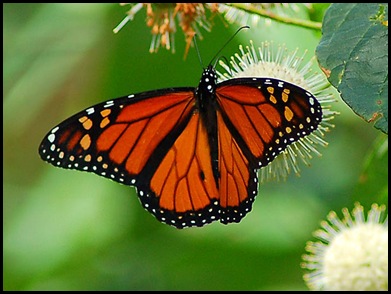Nancy Newlon has written and shared this amazing information with us about the Monarch Butterfly. It is so very interesting! Thanks Nancy!
When God created the wonders of nature, he shrouded one of his most fragile creations, the monarch butterfly, in mystery.
A few years ago I read an article about an organization called Monarch Watch and their tagging program of the monarch butterfly. By tagging, scientists were learning the story of the monarch’s remarkable migration. For several years I had noticed in the fall there were large numbers of monarchs hanging from my trees and floating through my back yard. After reading the article I realized my home was on the fall migration route of the monarch. I signed up for the tagging program and on September 11, 2000, I tagged my first monarch. Since that time I have tagged 100’s of monarchs. In 2003 I was excited to get a letter from Monarch Watching saying that a butterfly I had tagged had been recovered. It said that monarch No. BGW512 which I had tagged on 9/11/2002 had been recovered in ElRosario, Mexico by Leonel Garcia Martinez on 3/7/2003. This monarch traveled 1,485 miles. WOW!
Since I started tagging monarchs I have learned so many interesting facts about this butterfly. During the monarch’s migration to its winter home in the Sierra Madre Mountains in Mexico, it can travel up to 3,000 miles. This winter home is only 70 square miles. If you combined the Iowa counties of Fremont, Page, Taylor, Pottawattamie, Montgomery, and Adams, it would be an area approximately 70 square miles. The monarch migration is also amazing because the monarch returning to Mexico each fall is the great-great-great grandchild of the butterfly that left the previous spring. Monarchs who breed early in the summer live only a few weeks and are called summer monarchs. Adults die shortly after mating and laying eggs. Females lay their eggs only on milkweed plants and each female lays about 400 eggs. The egg is no bigger than the head of a pin.
Several generations of short lived monarchs are produced in early to mid-summer. However, in late August, shorter days and colder temperatures cause the emerging monarchs to postpone reproductive maturity. This generation is called the winter monarch and they migrate to the little 70 square mile winter home in Mexico. Remember, this is a place they have never been. When the weather starts to warm in the early spring, these winter monarchs will start heading north and after mating and laying eggs, they will die. The monarchs born are the short lived summer monarchs and they are the start of a new generation of monarchs.
For 100’s of years the monarch butterfly has found its way home to where its great-great-great grandparents lived the winter before. Scientists are baffled how a frail butterfly finds its way to the wintering grounds from a summer birthplace half a continent away. It can’t be from memory because this generation of monarchs has never been there. Scientists speculate the butterfly might rely on celestial navigation-possibly the rays of the sun to guide its flight. I am not baffled by the monarch’s precise navigation mechanism. It is just one of the wonders of nature created by God.
--Nancy Newlon


Very interesting. The Monarch is my favorite butterfly.
ReplyDeleteVery interesting. The Monarch is my favorite butterfly.
ReplyDelete